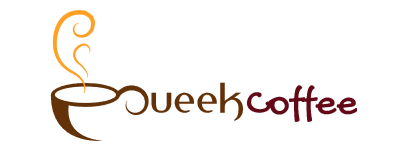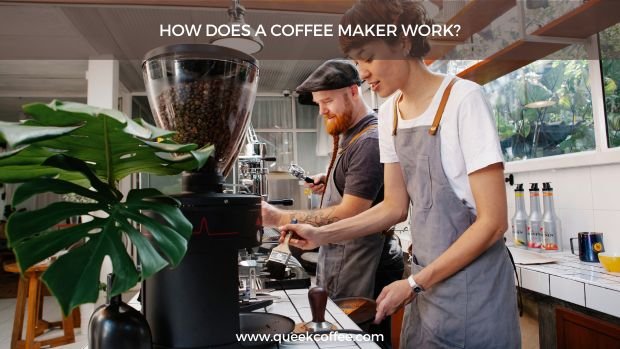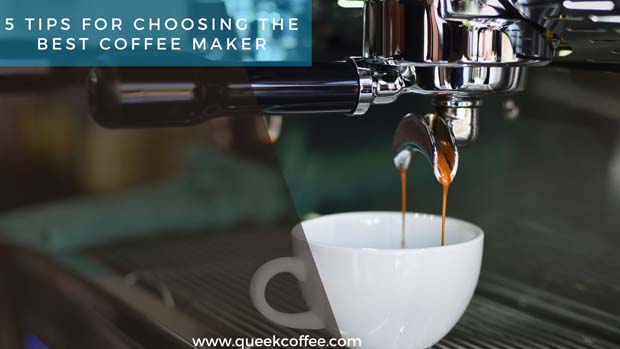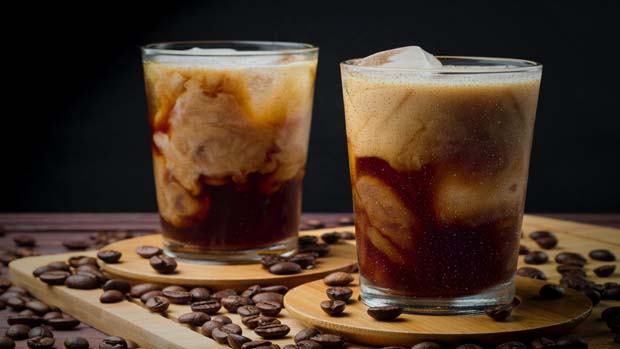Coffee is one of the most widely consumed beverages, with millions of people enjoying it daily. A coffee maker is a crucial device enabling you to conveniently brew your preferred coffee at home.
But have you ever wondered to think that how does a coffee maker work? In this article, we will delve into the fascinating process of brewing coffee and explore the inner workings of a coffee maker.
How Does a Coffee Maker Work?
What is a Coffee Maker?
A coffee maker is an electrical appliance designed to brew coffee quickly and efficiently. It makes coffee brewing easier and more approachable for those without barista-level skills. Several types and sizes of coffee makers are available to suit different preferences and requirements.
The Evolution of Coffee Makers
The history of coffee makers dates back centuries. From the traditional coffee pots used in ancient times to the modern, high-tech machines of today, the evolution of coffee makers has been remarkable—early methods involved boiling coffee grounds in water and using cloth or metal filters to separate the liquid. Over time, technological advancements led to the development of more sophisticated coffee makers that we use today.
Basic Components of a Coffee Maker
A standard coffee maker consists of several key components that work together to produce a perfect cup of coffee.
Water Reservoir
The water reservoir is where you pour water into the coffee maker. This reservoir is typically located at the back or side of the coffee maker. It’s an important element of a coffee maker. It holds the water until the brewing process begins.
Coffee Basket
The coffee basket is where you place the ground coffee. It acts as a filter, allowing the water to pass through while retaining the coffee grounds.
Brew Basket
The brew basket holds the coffee basket and helps distribute hot water over the coffee grounds.
Heating Element
The heating element is in charge of raising the water temperature to the correct level for coffee brewing.
Carafe
The carafe is a glass or thermal container that holds the brewed coffee. It is usually placed on a warming plate to keep the coffee hot.
The Brewing Process
Now let’s dive into the detailed steps involved in brewing coffee using a coffee maker.
Step 1: Water Intake
When you start the coffee maker, it first takes in the required water from the reservoir.
Step 2: Heating the Water
The heating element heats the water to the optimal temperature, usually between 195 to 205 degrees Fahrenheit (90 to 96 degrees Celsius).
Step 3: Drip or Espresso Brewing
The brewing method varies depending on the type of coffee maker. Drip coffee makers use a drip system, whereas espresso machines force hot water through the coffee grounds at high pressure.
Step 4: Coffee Extraction
During this step, hot water passes through the coffee grounds in the coffee basket or espresso machine, extracting the coffee’s flavor and aroma.
Step 5: Transferring Coffee to Carafe
The freshly brewed coffee drips into the carafe, ready to be served and enjoyed.
Types of Coffee Makers
Several coffee makers are available, each with unique brewing methods and characteristics.
Drip Coffee Maker
A drip coffee maker is a popular and user-friendly type of coffee maker that has earned its place in households worldwide. It operates by pouring water into a reservoir, which is then heated to the optimal brewing temperature.
The heated water is then dripped over coffee grounds and placed in a filter, allowing the coffee to extract its flavors and aromas slowly. The resulting brewed coffee then drips into a carafe or pot below, ready to be served.
Drip coffee makers come in various sizes and features, making them suitable for both individuals and families. With their ease of use and ability to brew larger quantities, drip coffee makers remain a staple for those seeking a convenient and reliable way to enjoy their favorite morning brew.
Espresso Machine
An espresso machine is a remarkable coffee maker that is cherished by coffee aficionados for its ability to produce rich and concentrated coffee known as espresso. This machine forces hot water through finely-ground coffee beans at high pressure, resulting in a small yet intense shot of espresso.
Espresso machines come in various types, including manual, semi-automatic, and fully automatic, catering to different levels of user control and convenience. The intense flavor and velvety crema produced by espresso machines have made them a favorite among those who appreciate the art and science of coffee brewing.
This versatile machine offers endless possibilities for coffee enthusiasts to savor their preferred coffee creations, from single shots to elaborate espresso-based drinks like cappuccinos and lattes.
French Press
The French press is a classic and beloved coffee maker known for its simplicity and ability to brew robust and full-bodied coffee. It consists of a cylindrical glass or metal carafe with a plunger and a fine mesh filter. Brewing with a French press involves adding coarsely ground coffee to the carafe, pouring hot water over it, and allowing it to steep for a few minutes.
After steeping, the plunger is pressed down, separating the coffee grounds from the brewed coffee. This method allows for maximum contact between the water and the coffee, resulting in a flavorful and aromatic cup of coffee.
The French press offers coffee enthusiasts control over the brewing time and intensity, making it a popular choice for those who enjoy a more hands-on approach to their coffee preparation. Its elegant design and the ability to preserve the coffee’s natural oils and flavors make the French press a timeless favorite among coffee connoisseurs.
Single-Serve Coffee Maker
The single-serve coffee maker is a convenient and modern innovation that has revolutionized the way people brew and enjoy coffee. As the name suggests, this type of coffee maker is designed to brew a single cup of coffee at a time, eliminating the need for traditional coffee pots or carafes.
Single-serve coffee makers use pre-packaged coffee pods or capsules filled with precisely measured coffee grounds. Users simply insert the pod, press a button, and a freshly brewed cup of coffee is ready to be savored within seconds. The beauty of the single-serve coffee maker lies in its simplicity and efficiency, making it an ideal choice for individuals who prefer personalized and hassle-free coffee brewing.
With a vast array of coffee flavors and blends available in pods, coffee lovers can explore a diverse range of tastes and aromas, all with the convenience of a single press of a button. Whether at home, in the office, or on the go, the single-serve coffee maker delivers a delightful coffee experience with minimal effort.
Factors Affecting Coffee Quality
Several factors influence the quality of the brewed coffee.
Coffee Ground Size
The size of the coffee grounds impacts the extraction process. While coarser grounds work best with drip coffee makers, finer grounds are best for espresso machines.
Water Temperature
The water temperature during brewing affects the flavor and strength of the coffee. Maintaining the right temperature is crucial for a perfect brew.
Brew Time
The time taken for brewing also plays a role in determining the coffee’s taste. Longer brew times may result in over-extraction and bitterness.
Cleaning and Maintenance
Proper cleaning and maintenance of your coffee maker are essential for the machine’s longevity and the quality of coffee it produces.
Regular Cleaning
Regularly cleaning the coffee maker helps remove coffee residues and oils that can affect the taste of future brews.
Descaling the Coffee Maker
Descaling is crucial to remove mineral deposits from the water reservoir and internal components, ensuring optimal performance.
Brewing Tips and Tricks
Here are some tips to enhance your coffee brewing experience.
Choosing the Right Coffee Beans
Selecting high-quality coffee beans with fresh roasting enhances the overall coffee flavor.
Water-to-Coffee Ratio
Maintaining the right water-to-coffee ratio is essential for a well-balanced and flavorful cup of coffee.
Experimenting with Flavors
Experiment with various coffee beans and flavorings to discover your perfect cup.
Common Issues and Troubleshooting
Sometimes, coffee makers may face issues that require simple troubleshooting.
Coffee Tastes Bitter
A bitter taste might indicate over-extraction or using too fine coffee grounds. Adjust the grind size and brewing time accordingly.
Coffee Maker Leaking
Leakage can occur due to loose components or worn-out gaskets. Check for any loose parts and replace damaged gaskets.
The coffee Maker is Not Turning On
If your coffee maker doesn’t turn on, ensure it’s correctly plugged in and check the power source.
Final Thoughts
Your enthusiasm for this daily habit may be enhanced if you understand how a coffee maker works. Each step, from the input of water to the final extraction, goes into making the delicious cup of coffee that delights so many coffee drinkers around the world. Take a moment to appreciate the science and art involved in creating this popular beverage the next time you prepare your favorite cup of coffee.

MD Azizul Hakim is a content creator and the co-founder of www.queekcoffee.com. He has been writing content and reviews for over five years. He loves to brew coffee and serve it with his colleagues.





